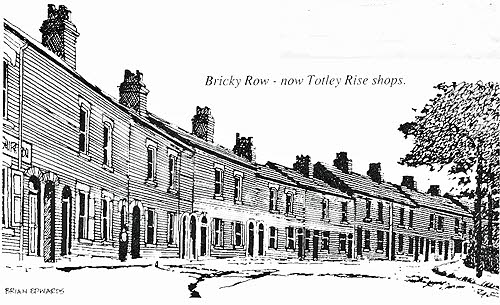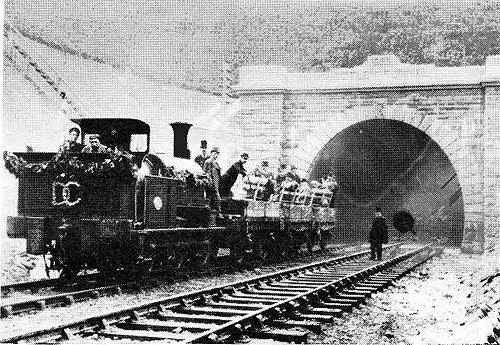|
From Door To Dore in 1994
Reproduced from the Summer edition 1994 of Dore to Door with kind permission of the Dore Village Society.
Totley Tunnel Centenary - 1994
This year sees the 100th anniversary of the opening of the tunnel to passenger transport, a construction achievement equivalent in its day to the Channel Tunnel.
Throughout the nineteenth century there were several plans to improve the link between the large industrial cities of Sheffield and Manchester by road, canal and railway. It was not until 1893 that the Dore and Chinley railway line was opened for goods traffic and June 1894 saw the first passengers cross the Pennines by this route.
The greatest achievement of this railway was the construction, by Thomas Oliver of Horsham, of the Totley tunnel - 3 miles and 950 yards long. In October 1888, work began at both Totley and Grindleford. The line of the tunnel had been set out from three high points - Bradway Summit, the moor above the tunnel and on Sir William Hill, Grindleford. A line was laid out on the ground and small shafts were bored at intervals. The line and depth of the tunnel was established by suspending weighted wires, of known length, down shafts and by the use of a theodolite at the headings. The accuracy of this method was such that when the headings met, the centre line was only 4.5" out of line horizontally and 2.25" vertically.
Four permanent shafts were sunk within a mile of the Totley end. These were used both for ventilation and as a base for the excavation of the headings. The main problem was water, which flooded into the tunnel. In June 1889, 26,000 gallons of water were being pumped away each hour.
A contemporary report from the Manchester Guardian declared "every man seemed to possess the miraculous power of Moses, for whenever a rock was struck, water sprang out of it."
As the miners tunnelled, they were followed by bricklayers who arched the tunnel - the sides being lined with large blocks of stone with brick arches above. Many of the bricks used were produced locally at the Totley Moor works. By August 1889 boring was progressing at the rate of 18 yards each week.
Working conditions were poor, with lighting by tallow candles and always with the danger of great in rushes of water. 163 tons of gelignite were used to blast away the rock, the waste material being hauled up above ground and dumped, covering large areas of what was Nether Bentley below the Crown Inn.
Many labourers were brought in to help with the work. They arrived with their wives and families. Accommodation was provided in huts built around the shafts and many lodged in houses in the area. It was quite common for dozens of people to share a house and living conditions were generally disgusting. Many homes were without water, and raw sewage ran into the gardens.
At Totley the incomers actually outnumbered the local residents. The navvies' fondness for drink, poaching and gambling - prize-fights and horse races were laid on at Owler Bar - boosted the local crime rate alarmingly, keeping the police and courts very busy. In their defence, it was acknowledged that working conditions were appalling; accidents were a common occurrence and it was difficult to keep enough labourers on the payroll. A working day was one of three 8- hour shifts and in mid-1889 the pay was 3s 2d per week.
Not surprisingly, there were many complaints about the rough behaviour of the navvies. Drunkenness was common, much of the money earned being spent in the alehouses of Dore and Totley. The nomadic lifestyle of the navvies was not conducive to a good education or healthy practices.
There was a smallpox outbreak in 1893, which caused deaths amongst this group, who had not been vaccinated. There are 17 entries in the Register of Burials at Dore Church between March and July 1893, which have S.P. after the name. Of these eleven were Bricky Row - now Totley Rise shops. 8 infants and children. Seven died at the Smallpox Hospital, Totley, which was sited at Green Oak.

Tales of those who drove Totley tunnel are still told by their descendants. The grandfather of Mrs Rosemary Lockie met and married a local girl after coming to find work with a gang of his mates when their jobs on the Severn tunnel came to an end. He was skilled in the use of explosives and in later years used to tell how he was one of the men who shook hands with those who made the final 'breakthrough' from the opposite, Dore, end of the tunnel. Lifelong resident Miss Amy Schofield, recalls a Welsh relative who brought his family to live in Hathersage. Nicknamed "Jimmy the Whip', he became a foreman on the tunnel. When it was completed he took his family on to Clay Cross and found new work.
Totley and the Tunnel
No article on the tunnel would be complete without reference to Brian Edwards's definitive book on the tunnel. In words, pictures, drawings and maps, this tells the fascinating human and engineering story about the building of the tunnel. A must for anyone interested in our local history, it is available from the Shape Design Shop on Abbeydale Road South.
Tunnel Top Walk
As part of the Totley Tunnel celebrations there will be a Spring Bank Holiday Monday walk following the line of the tunnel above ground.
Starting 9.15am at Dore Station, then by train to Grindleford, the free guided walk will take approximately 3 hours across the Longshaw Estate and Totley Moor, down Penny Lane and Totley Brook Road, back to Dore Station. In addition to the scenic route there will be an opportunity to see some of the local features resulting from the tunnel's construction. For more details, including confirmation of timing, ring John Baker on Sheffield xxxxxx.
Tunnel Centenary Events -1994
Local events celebrating the centenary of the opening of Totley Tunnel are planned to stretch over a period beginning at the Bank Holiday on 28-30 May and culminating at a Carnival on the cricket field behind the Cricket Inn on 26 June. Some of the scheduled events are:
MAY 1994
30 Walk along the line of the tunnel. See separate item.
JUNE 1994
8 Talk on Totley Tunnel by Brian Edwards. 7pm Totley Library.
18-19 Exhibition commemorating the opening of the Dore & Chinley Line. All Saints Church Hall, Totley Hall Lane.
25 Fete in Edale. 12noon-4pm on the playing field. Steam roller, rides & Hathersage Band. Evening Barn Dance. Ring xxxxxxxxxxx for full weeks programme.
26 Steam train. Jubilee Class loco No 45596 "Bahamas". Leaves Man Victoria 9.15am arrives Sheffield 11am.
Leaves Sheffield 12.20 arrives Manchester 13.45.
Leaves Manchester 15.00 arrives Sheffield 16.25
Leaves Sheffield 18.00 arrives Manchester 19.45. £15 single fare.
Tickets from James Shuttleworth, xxxxxxxx. Tel xxxxxxxxxx.
26 Carnival event & Totley Sports day at the Cricket Inn and Totley Bents Field. See posters for details.
27 Talk - see 8th. 10am Holy Trinity Church Hall, Millhouses.

Full steam ahead. Local dignitaries are shown Totley Tunnel shortly before its official opening to regular passenger traffic in 1894.
Lost corner of Dore
The building of the Dore to Chinley Line put paid to a 1876 scheme for a Totley Brook estate, laid out each side of the drive to Grove House (see map). The line of the railway cut across the drive leaving present day Grove Road and Grove Lodge (next to the Methodist Church) on one side and a realigned Totley Brook Road on the other. The few remaining stone houses on Grove Road and similar ones at the far end of Totley Brook Road, are the only reminders of the scheme.
The boundary of Dore being Old Hay Brook, the railway effectively cut off the corner of Dore incorporating Grove Road and its modern additions. To mark the centenary we aim to put right this injustice and extend the circulation of Dore to Door to this lost corner! Welcome then to new readers in some 60 households.
Brian Edwards

|